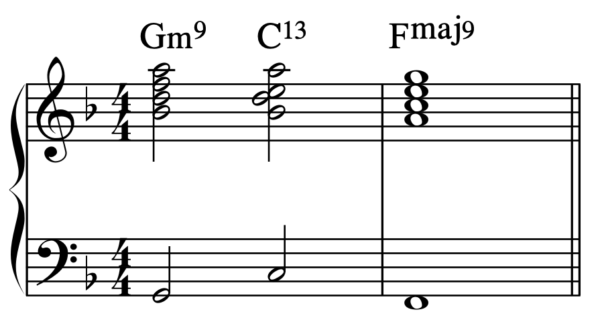Easy steps to learning jazz piano part 5
Here is the fifth episode in this series of easy steps to learning jazz piano
In episode 1 we looked at the relationship between two notes: the 5 (dominant) and the 1 (tonic).
The second step in episode 2 was to convert these two notes into chords: the dominant 7 chord leading to the tonic chord. An example would be D7 – G or A7 – E. The tonic chord can be major or minor.
In episode 3, we added a third chord, the ‘II’. This is usually a minor 7. And now we have the most important 3-chord sequence in jazz: The II-V-I sequence.

The graphic above shows a voicing of the II-V-I sequence in F major.
Part 4 of easy steps to learning jazz piano we explored ways of soloing through this sequence. Here is an example with some passing notes.

In part 5 of this series of easy steps to learning jazz piano we now examine the notes we can add in or solos to the dominant 7 to spice things up.
And as I’ve said many times before, it is the dominant 7 chord that holds the tension and we can increase this tension by adding notes not found in the chord (extensions) and notes not found in the scale (alterations, also known as altered notes.)
Extensions
There are three notes known as extensions: 9, 11 and 13. These three notes do note appear in the dominant 7 chord but do appear in the Mixolydian mode. This mode is the same as a major scale but with a flattened 7.
In the graphic below you will see a G7 chord (G+B+D+F) and the Mixolydian mode of G (G, A, B, C, D, E, F, G.)
The three notes that don’t appear in this chord but do appear in G Mixolydian are A, C and E. These can be numbered as 9, 11 and 13.

Alterations
There are four notes known as alterations or altered notes and they derive from the three extensions.
From the ‘9’ extension we get b9 and #9.
From the ’11’ extension we get #11.
From the ’13’ extension we get b13.
Here is a graphic showing these four alterations related to G7.

/And here is a link to my YouTube video relating to this lesson.
In the next episode of easy steps to learning jazz piano we will explore ways of using these notes on our solos.
If you feel ready to subscribe to my full Learn Jazz Piano Online video course click here!